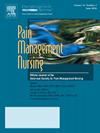Factors Associated With Physical Function in Adults With Fibromyalgia
IF 1.6
4区 医学
Q2 NURSING
引用次数: 0
Abstract
Background
Fibromyalgia is a chronic pain condition that impacts 10 million people across the United States. While chronic pain is central in fibromyalgia, individuals with fibromyalgia also experience poor sleep quality, frequent headaches, fatigue, decreased physical function, increased anxiety and depression, and report a higher level of comorbid health conditions compared to individuals with other types of chronic pain.
Purpose/Aim
To identify variables that are associated with physical function and furthermore determine if these variables have an impact on physical function.
Methods/Design
An observational study was conducted, distributing surveys asking questions about age, race, sex, work status, education level, psychological resilience, comorbidities, pain intensity, depression, and physical function. Bivariate correlations were determined and a linear regression run utilizing SPSS version 29.
Results
Age, race, psychological resilience, pain intensity, comorbidities, and employment status all significantly correlate with physical function. The linear regression suggests psychological resilience, comorbidities, and employment status have significant effects on physical function.
Conclusion
Age, race, psychological resilience, pain intensity, comorbidities, and employment status all significantly correlate with physical function. The linear regression suggests psychological resilience, comorbidities, and employment status have significant effects on physical function
Implications for Nursing Profession
Nurses should pay attention to patient comorbidities, pain intensity, age, and race when determining how best to support the patient with fibromyalgia. Identifying interventions that concentrate on supporting psychological resilience could have a positive impact on overall physical function. Nurses need to see beyond the immediate pain the patient presents with and look at the individual's holistic wellbeing.
Implications for future research
More research is needed into variables that impact physical function in individuals with fibromyalgia. Pain intensity, and therefore medication to treat pain intensity, are only one facet of a comprehensive care plan. A better look at sociodemographic factors and at support systems are essential to the care and wellbeing of a patient with fibromyalgia.
求助全文
约1分钟内获得全文
求助全文
来源期刊

Pain Management Nursing
医学-护理
CiteScore
3.00
自引率
5.90%
发文量
187
审稿时长
>12 weeks
期刊介绍:
This peer-reviewed journal offers a unique focus on the realm of pain management as it applies to nursing. Original and review articles from experts in the field offer key insights in the areas of clinical practice, advocacy, education, administration, and research. Additional features include practice guidelines and pharmacology updates.
 求助内容:
求助内容: 应助结果提醒方式:
应助结果提醒方式:


